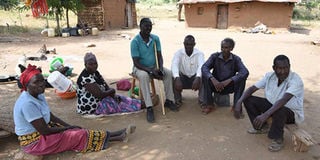Kiptani community wants recognition as tribe to end marginalisation

Members of the Kiptani tribe, at Kiptani Sub-location in Keiyo North of Elgeyo-Marakwet County on January 27, 2020. They claim they have been marginalised by successive governments. PHOTO | JARED NYATAYA | NATION MEDIA GROUP
What you need to know:
- The community lives in Emsoo ward in Elgeyo-Marakwet County and is found in Kabulwo and Chegilet areas.
- Members say they are a minority sub-tribe of the Kalenjin community but they have been falsely grouped as Keiyo.
- Peter Barng'etuny, a member of the community, said they had petitioned the State in the past over the request but without success.
The Kiptani community in Elgeyo-Marakwet County wants the State to recognise it as a tribe.
The community alleged that it has been sidelined in government appointments.
Members said they were a minority sub-tribe of the Kalenjin community but they had been falsely grouped as Keiyo. They said they spoke a different dialect from other Kalenjin sub-tribes.
They claimed that none of their members had been recruited into the disciplined forces such as Kenya Defence Forces or Kenya Wildlife Service even though they hold national identity cards.
They said that despite donating part of their community land for the establishment of the Rimoi National Game Reserve, they had not been recruited as game wardens at the reserve that was re-opened in 2016.
ELECTIVE POSTS
“We don’t have a single individual nominated or elected to any position since we are a minority group. We feel sidelined and that is why we want the government to recognise us as a tribe so that we can be considered for these opportunities,” said Mr Charles Rono, one of the community members.
The community lives in Emsoo ward in Elgeyo-Marakwet County and is found in Kabulwo and Chegilet areas.
According to Mr Julius Chelagat, the community, comprising about 4,000 members, originated from the neighbouring Baringo County.
ASSIMILATED
He said that some of their members have been assimilated into other communities through inter-marriages.
“We live in Keiyo North Sub-County even though we are not Keiyo. We border the Marakwet and Tugen communities. Most of our traditions and culture are similar such as in male circumcision but we differ on language and age-set naming system. Our forefathers engaged in hunting and gathering before learning about farming from the two communities,” the community elder told the Nation.
Mr Peter Barng'etuny, a member of the community, said they had petitioned the State in the past over the request but without success.
He said they had in the past presented a petition to representatives from the National Gender and Equality Commission during a meeting in Iten town.
MARGINALISED
“They promised to follow up on the matter with other agencies but, since then, we have never heard anything from them,” said Mr Barng'etuny, a former councillor during the Kanu regime.
He said that most of the roads in the region were in a sorry state due to marginalisation and appealed to the government to come to their aid.
The community has nine clans which are: Terik, Kobil, Toyoi, Kimoi, Tungo, Tula, Sogome, Saniak and Sote.
In 2017, through a special Gazette notice, President Uhuru Kenyatta gazetted the recognition of Kenyans of Indian decent as the 44th tribe in Kenya and invited them to take part in the political, economic, cultural and social development of the nation.
The recognition, under the presidential proclamation, followed President Kenyatta’s similar recognition of members of the Makonde community, originally from Mozambique and now living in the Coastal region of Kenya, as the 43rd tribe in Kenya.





